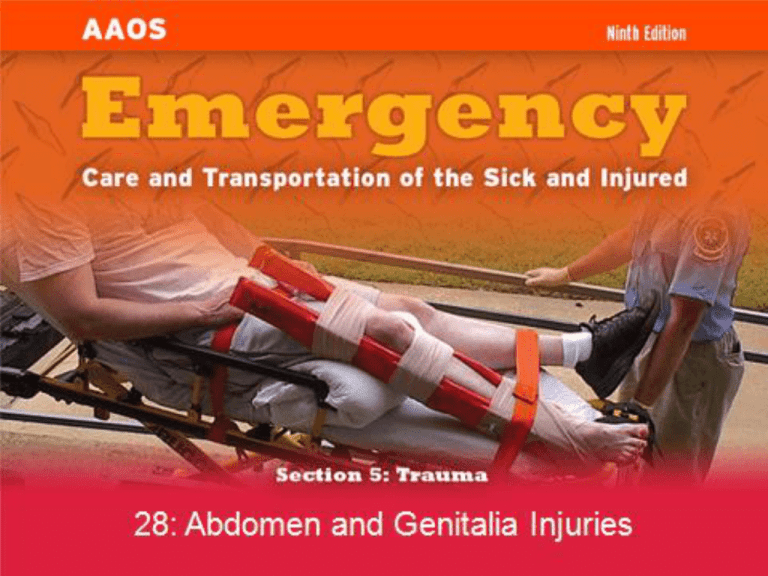Chapter-28-Part-B
advertisement

Female Reproductive System Care for Injuries of the Female Genitalia (1 of 2) • Female internal genitalia is well protected and usually not injured. • The exception is the pregnant uterus which is vulnerable to both blunt and penetrating injuries. – Keep in mind that the unborn child is also at risk. – Expect to see signs and symptoms of shock. – Provide all necessary support. – Transport promptly. Care for Injuries of the Female Genitalia (2 of 2) • Injuries to the external genitalia are very painful but not life threatening. • Treat lacerations, abrasions, and avulsions with moist, sterile compresses. • Use local pressure and a diaper-type bandage to hold the dressing in place. • The urgency of transport will be determined by the associated injuries, amount of hemorrhage, and the presence of shock. Rectal Bleeding • Common complaint • Blood may appear in undergarments or may be passed during a bowel movement. • Can be caused by sexual assault, hemorrhoids, colitis, or ulcers of the digestive tract • Acute bleeding should never be passed off as something minor. • Pack the crease between the buttocks with compresses and consult with medical control. Sexual Assault • Do not examine genitalia unless there is obvious bleeding. • The patient should not wash the area, defecate, eat, or drink until examined. • Offer to call the local rape crisis center. • Document carefully and preserve evidence. Review 1. Which of the following organs would be the MOST likely to bleed profusely if severely injured? A. Liver B. Kidney C. Stomach D. Gallbladder Review Answer: A Rationale: The liver is a highly vascular solid organ, and contains approximately 40% of the body’s total blood volume at any given time. If severely injured, bleeding from the liver would be profuse and rapid. Other solid organs, such as the spleen and kidneys, may also produce severe bleeding if injured, though not as rapid as the liver. The stomach and gallbladder are hollow organs; if lacerated, they would spill their contents into the abdominal cavity, resulting in peritonitis. Review 1. Which of the following organs would be the MOST likely to bleed profusely if severely injured? A. Liver Rationale: Correct answer B. Kidney Rationale: This will produce bleeding, but not as rapidly as the liver. C. Stomach Rationale: This hollow organ will spill its contents into the abdominal cavity. D. Gallbladder Rationale: This hollow organ will spill its contents into the abdominal cavity. Review 2. Which of the following statements regarding intraabdominal bleeding is FALSE? A. Intraabdominal bleeding often causes abdominal distention B. Intraabdominal bleeding is common following blunt force trauma C. The absence of pain and tenderness rules out intraabdominal bleeding D. Bruising may not occur immediately following blunt abdominal trauma Review Answer: C Rationale: Intraabdominal bleeding is common following blunt trauma to the abdomen. Signs include abdominal distention, rigidity, bruising (may not occur immediately), and in some cases, pain to palpation. However, unlike gastric juices and bacteria, blood within the abdominal cavity does not provoke an inflammatory response; therefore, the absence of pain and tenderness does not rule out internal bleeding. Review 2. Which of the following statements regarding intraabdominal bleeding is FALSE? A. Intraabdominal bleeding often causes abdominal distention Rationale: You may see evidence of abdominal distention. B. Intraabdominal bleeding is common following blunt force trauma Rationale: This is a common condition following blunt trauma. C. The absence of pain and tenderness rules out intraabdominal bleeding Rationale: Correct answer D. Bruising may not occur immediately following blunt abdominal trauma Rationale: This may not occur immediately. Review 3. Other than applying a moist, sterile dressing covered with a dry dressing to treat an abdominal evisceration, an alternative form of management may include: A. placing dry towels over the open wound. B. cleaning the exposed bowel with sterile saline. C. applying the PASG to stop the associated bleeding. D. applying an occlusive dressing, secured by trauma dressings. Review Answer: D Rationale: Although the preferred management for an abdominal evisceration includes the application of a moist, sterile dressing covered by a dry dressing, protocols in some EMS systems call for an occlusive dressing, secured by trauma dressings. An occlusive dressing may help prevent the loss of body heat through the abdominal wound. Review 3. Other than applying a moist, sterile dressing covered with a dry dressing to treat an abdominal evisceration, an alternative form of management may include: A. placing dry towels over the open wound. Rationale: Treatment is a moist, sterile dressing over the open wound. B. cleaning the exposed bowel with sterile saline. Rationale: EMS should not clean any exposed abdominal organs. C. applying the PASG to stop the associated bleeding. Rationale: PASG inflation is contraindicated with an abdominal evisceration. D. applying an occlusive dressing, secured by trauma dressings. Rationale: Correct answer Review 4. You are transporting a patient with possible peritonitis following trauma to the abdomen. Which position will he MOST likely prefer to assume? A. Sitting up B. Legs drawn up C. Legs outstretched D. On his right side Review Answer: B Rationale: Patients with peritonitis often lie very still and tend to have their legs drawn up into the abdomen. This relieves strain on the abdominal muscles and may provide pain relief. Review 4. You are transporting a patient with possible peritonitis following trauma to the abdomen. Which position will he MOST likely prefer to assume? A. Sitting up Rationale: Lying very still with the legs drawn up will help relieve the patient’s pain. B. Legs drawn up Rationale: Correct answer C. Legs outstretched Rationale: The patient’s legs drawn up or flexed will help relieve pain. D. On his right side Rationale: The patient’s legs drawn up or flexed will help relieve pain. Review 5. A 16-year-old boy was playing football and was struck in the left flank during a tackle. His vital signs are stable; however, he is in severe pain. You should be MOST concerned that he has injured his: A. liver. B. spleen. C. kidney. D. bladder. Review Answer: C Rationale: The flanks are located laterally in the back and overlie the kidneys. During football, spearing injuries occur when a player is struck in the flank by another player’s helmet. This can result in injury to the kidney ranging from bruising to severe bleeding. Injury to the liver, spleen, and bladder would more likely occur following blunt trauma to the anterior abdomen. Review 5. A 16-year-old boy was playing football and was struck in the left flank during a tackle. His vital signs are stable; however, he is in severe pain. You should be MOST concerned that he has injured his: A. liver. Rationale: The liver is associated with an injury to the anterior abdomen and right upper quadrant. B. spleen. Rationale: The spleen is associated with an injury to the anterior abdomen and left upper quadrant. C. kidney. Rationale: Correct answer D. bladder. Rationale: The bladder is associated with an injury to the anterior abdomen and midline in the lower quadrants. Review 6. While inspecting the interior of a wrecked automobile, you should be MOST suspicious that the driver experienced an abdominal injury if you find: A. a deformed steering wheel. B. that the airbags deployed. C. a crushed instrument panel. D. damage to the lower dashboard. Review Answer: A Rationale: Airbags save lives when used in conjunction with properly worn seatbelts. Unfortunately, however, not all drivers wear their seatbelts. If unrestrained, the driver’s abdomen may strike the steering wheel, resulting in significant trauma. Suspect this if you lift the airbag and note that the lower part of the steering wheel is deformed. Review 6. While inspecting the interior of a wrecked automobile, you should be MOST suspicious that the driver experienced an abdominal injury if you find: A. a deformed steering wheel. Rationale: Correct answer B. that the airbags deployed. Rationale: Typically, the face and chest are impacted by airbags if safety belts are worn properly. C. a crushed instrument panel. Rationale: This would indicate the possibility of leg and hip injuries. D. damage to the lower dashboard. Rationale: This would indicate the possibility of leg and hip injuries. Review 7. When caring for a female with trauma to the external genitalia, the EMT-B should: A. use local pressure to control bleeding. B. carefully pack the vagina to reduce bleeding. C. remove any impaled objects from the vagina. D. cover any open wounds with moist, sterile dressings. Review Answer: A Rationale: Bleeding from the external genitalia should be controlled by applying a dry, sterile dressing and local direct pressure. Never pack anything into the vagina to try to control bleeding; this increases the risk of infection, and anything you place into the vagina will only need to be removed at the hospital. Impaled objects in the genitalia should be carefully stabilized in place, not removed. Review 7. When caring for a female with trauma to the external genitalia, the EMT-B should: A. use local pressure to control bleeding. Rationale: Correct answer B. carefully pack the vagina to reduce bleeding. Rationale: Never pack anything into the vagina. C. remove any impaled objects from the vagina. Rationale: Impaled objects are stabilized in place and are not removed. D. cover any open wounds with moist, sterile dressings. Rationale: Apply dry, sterile dressings with local direct pressure. Review 8. Peritonitis would MOST likely result following injury to the: A. liver. B. spleen. C. kidney. D. stomach. Review Answer: D Rationale: In general, solid organs bleed when injured and hollow organs spill their contents into the abdominal cavity, resulting in peritonitis—inflammation of the intraabdominal lining. Of the choices listed, the stomach is the only hollow organ. Review 8. Peritonitis would MOST likely result following injury to the: A. liver. Rationale: The liver typically bleeds into the abdominal cavity. B. spleen. Rationale: The spleen typically bleeds into the abdominal cavity. C. kidney. Rationale: The kidneys typically bleed into the retroperitoneal space and not into the abdomen. D. stomach. Rationale: Correct answer Review 9. The term “hematuria” is defined as: A. blood in the stool. B. blood in the urine. C. vomiting up blood. D. urinary bladder rupture. Review Answer: B Rationale: Blood in the urine is called hematuria. Following trauma, the presence of hematuria suggests injury to the urinary bladder or kidneys. Bright red blood in the stool is called hematochezia; dark, tarry stools are called melena. Vomiting up blood is called hematemesis. Review 9. The term “hematuria” is defined as: A. blood in the stool. Rationale: This is known as hematochezia or melena (dark stools). B. blood in the urine. Rationale: Correct answer C. vomiting up blood. Rationale: This is known as hematemesis. D. urinary bladder rupture. Rationale: This will produce abdominal pain and eventually peritonitis due to a leaking into the abdominal cavity. It will also cause a lack of/or a reduction of urinary output. Review 10. Even when seatbelts are worn properly and the airbags deploy, injury may occur to the: A. chest. B. extremities. C. iliac crests. D. lower ribcage. Review Answer: C Rationale: Seatbelts should be positioned over the iliac crests of the pelvis. If they are positioned higher, significant intraabdominal injury can occur. Even when seatbelts are properly positioned and the airbags deploy, injury to the iliac crests may occur as the locking mechanism of the seatbelt engages during a motor-vehicle crash that involves rapid deceleration. Review 10. Even when seatbelts are worn properly and the airbags deploy, injury may occur to the: A. chest. Rationale: If the seatbelts are worn too high, then abdominal injuries may occur. B. extremities. Rationale: The extremities are not likely to be injured if seatbelts are worn properly. C. iliac crests. Rationale: Correct answer D. lower ribcage. Rationale: If seatbelts are worn too high, then abdominal injuries may occur.







